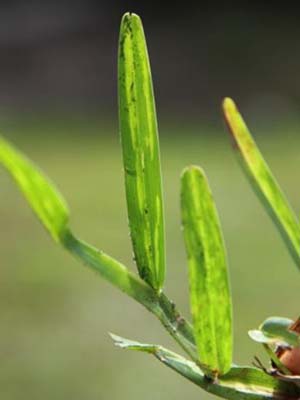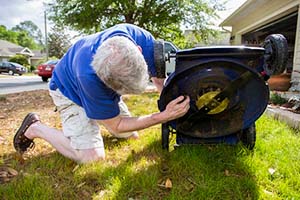Sugarcane Mosaic Virus in Florida Turfgrass
The following is an abbreviated update on mosaic disease caused by sugarcane mosaic virus (SCMV) in Florida turfgrass. A more detailed report is available through Ask IFAS.

St. Augustinegrass infected with sugarcane mosaic virus, UF/IFAS.
Recent reports of mosaic disease caused by sugarcane mosaic virus (SCMV) give gardeners reason to be cautious. SCMV is named for its original host, sugarcane, but it affects turfgrasses throughout Florida.
Before 2013, reports of the virus were few and far between. When they did occur, cases were generally mild. In the past few years however the virus has spread. It is now confirmed in counties in North, Central, and South Florida.
Below are answers to a few questions commonly asked about SCMV.
What is Sugarcane Mosaic Virus (SCMV)?
Sugarcane mosaic virus causes mosaic disease in St. Augustinegrass. As a viral infection, mosaic disease cannot be controlled by fungicides or other pesticides. In some cases infection leads to severe damage. In the worst cases, the disease may kill the entire lawn as the turfgrass declines. This is referred to as lethal viral necrosis (LVN).
Some cultivars of St. Augustinegrass are more at risk than others. 'Floratam' is particularly vulnerable and can progress to LVN. This is particularly true in South Florida. 'Palmetto' and 'CitraBlue' are more resistant. SCMV also affects sugarcane, bermudagrass, seashore paspalum, bahiagrass, and fountaingrasses. Zoysiagrass does not appear to be a host.
What are the Symptoms of SCMV?
The most common symptom of mosaic disease caused by SCMV is a mosaic pattern of leaf damage. Look for blotchy lines of yellow and light green on green blades of grass. These broken streaks run along the veins. By the fall some lawns show LVN and begin to brown and die completely. In these cases lawns showed severe die-back by spring.
How Does SCMV Spread?

Keeping equipment clean can prevent the spread of disease, UF/IFAS.
Sugarcane mosiac virus is spread when machinery brings clippings and sap from an infected lawn to an uninfected lawn. This happens when lawn care equipment is not disinfected between landscapes. To avoid spreading the virus, clean all obvious clippings and sap off of all equipment. Pay special attention to mowers, trimmers, and shoes.
Next, sterilize the equipment by spraying with a sanitizing solution. Dilute bleach, alcohol, quaternary ammonia, are the most common choices.
The virus is also spread by aphids. Infected sod can spread the virus too, but SCMV hasn't been found on any sod farms to date. Inspect sod before installing it in your lawn. As always, a heathy lawn is more resistant to disease than a struggling one. Follow best management practices and your lawn will thank you.
What Should I Do If I Suspect My Lawn Has a Mosaic Disease?
Yellowed streaks are a symptom of a number of turfgrass diseases. Before you take action, confirm that SCMV is present in your turfgrass. You can submit a turfgrass sample for testing. Contact the UF/IFAS Plant Diagnostic Center for more information.
For questions about mosaic diseases and help identifying SCMV, contact your county Extension office.
Also on Gardening Solutions
- Best Management Practices for Your Lawn
- Disinfecting Your Garden Tools
- Lawn Diseases
- Viruses and Plant Disease
More from UF/IFAS
- AskIFAS: Mosaic Disease of St. Augustinegrass Caused by Sugarcane Mosaic Virus
- UF/IFAS Plant Diagnostic Center
- UF/IFAS Miami-Dade Blog: FAQ on Lethal Viral Necrosis (associated with Sugarcane Mosaic Virus-SCMV)
- UF/IFAS Miami-Dade Blog: What you should know about Sugarcane Mosaic Virus (SCMV) affecting St. Augustinegrass

